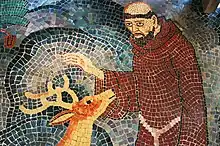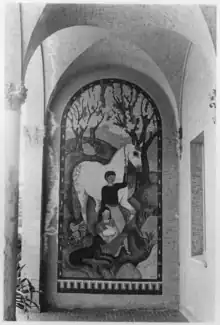Helen Bell Bruton
Helen Bell Bruton (February 7, 1898 – November 16, 1985) was an American printmaker, mosaic muralist and painter.
Helen Bell Bruton | |
|---|---|
| Born | February 7, 1898 Alameda, California, U.S. |
| Died | November 16, 1985 (aged 87) Monterey, California, U.S. |
| Education | University of California, Berkeley, Art Students' League |
| Occupation(s) | Printmaker, mosaic muralist |
| Notable work | Fleishacker Zoo Mother House mosaic, Portrait panels at Mudd Memorial Library |
Biography
She was the daughter of Daniel Bruton (1839-1928) and Helen Bell Bruton (1866-1956). Daniel and Helen Bell married in 1893. As a successful tobacco merchant, Daniel commissioned Denis Straub & Son to construct the family home at 1240 St. Charles Street in Alameda. Hellen had two sisters: Margaret Bruton (1894-1983) and Anne Esther Bruton Gilman (1896-1992).
Helen Bruton began her formal studies at the University of California, Berkeley,[1][2]: 11 but her education was interrupted by World War I.[3] During the war, she and her sisters contributed to the war effort at the occupational therapy ward of the Letterman Hospital in San Francisco.[1]: 51 In 1920-21, for two years,[4] she continued her artistic education in New York at the Art Students' League, learning under sculptors Alexander Calder, who was teaching there between 1918–22, and Leo Lentelli.[4][2]: 23 Later, she was also studying in New York under Boardman Robinson in his drawing class.[3] In her 1975 interview, however, she did not recall any strong artistic influences in her career.[4] She and her sisters' source of income, including the time of Great Depression, was partially based on their San Francisco property rental. Asked about her style she replied "I've always been more interested in people, I never was a very abstract thinker", she considered herself, to some extent, a late Ashcan School artist[5]
Early Monterey Period (1922-1929)
There were two periods when Helen Bruton resided in Monterey, California. The family built and furnished a house in Monterey[1]: 52 and stayed in it "on and off" as it was their summer place and "Monterey was small and simple at that time".[4] She recalls:[3]
[..] we were here in Monterey from about 1922 to 1929, and that’s what I consider the golden age of Monterey from my standpoint because it was so lovely and there was such an interesting group of artists here at the time. It was a very stimulating period. Of course, Armin Hansen had a class and a lot of the younger people gravitated around his class, but there were others. There was Price, and Gay, and the other people who were painting on their own, and I was on the fringe, sculpting, supposedly.
She was associated with the Monterey Group of painters who were meeting at the French Hotel. Some of them were associated with the Society of Six. [6]
Early Great Depression years
In 1929, while her sisters embarked on an artistic expedition to New Mexico (Taos and Santa Fe),[7]: 49 Bruton moved to Los Angeles. There, she worked at the Gladding McBean tile company, creating terra cotta portrait panels which are now preserved at the University of Southern California's Mudd Memorial Library.[4] When the stock market crashed in 1929 she was in Los Angeles finishing the "philosophers" job.[4] She recalls:[3]
I remember the dean’s name was Ralph Fluelling. It must have been the philosophy library because it was strictly portraits of philosophers. There were twenty-two panels for the twenty-two philosophers. The job had already been started. I think they had gotten as far as Confucius. I don’t know whether there was anyone earlier than that, but I came in at the Greek period and I had quite a series of Greeks to do, which incidentally I enjoyed very much. And then it came on up through the centuries to Spinoza and some of the English philosophers. Finally, I don’t think it got any farther than Emerson, but it got harder and harder for me; because I don’t know why, but I felt much more at home with the Greeks, and by the time I got to Emerson, I was really bogged down.
She and her sisters continued to exhibit at Beaux Arts Galerie (116 Maiden Lane)[8] in San Francisco where she presented wood blocks art, tiles, and prints.[1]: 53 One of the prints displayed was titled "The Party," it was etched on the occasion of a party held at the Stevenson's House in Monterey to bid farewell to someone leaving for Paris to study art.[5]
Mosaic art (1933-1939)

In 1930' she ventured into the world of mosaics working on projects supported by Public Works Administration and Works Progress Administration.

Partnering with her sister Margaret[4] she designed the exterior mosaic panels for the Fleishacker Zoo Mother House in San Francisco, an undertaking of the Federal Art Project. That project started at the end of 1933 with local materials and with the technical help of Antonio (Anthony) Falcier, an Italian mosaic maker who previously worked on Neptune Pool at Hearst Castle in San Simeon:
We used for the material some commercial tile that was manufactured at that time in San Jose, California, by a small tile outfit called Solon & Schennell, or the S&S Tile Company. They made a beautiful commercial tile [..] We had names for these tile colors, one was called St. Francis, and St. Francis varied in color all the way from deep Mars violet to a fawn color almost, or a strong ochre color, warm ochre, but it was the same glaze, depending on where it was put in the kiln it would come – that would be the range of shades.
One of the mosaics showcases a boy and a girl alongside a horse, dog, and rabbit, titled Children and Their Animal Friends. The second mosaic, St. Francis, portrays the revered protector of animals and the namesake of San Francisco, encompassed by a deer, wolf, snake, and several birds.
Bruton was also an active member of the California Society of Etchers and the Progressive California Painters. Her artwork found a platform in various exhibitions, notably the Golden Gate International Exposition in 1939.
In 1935, Egyptian-style mosaics by Helen Bruton were added in the entryway of the Golden West Hotel.[9]
Helen Bruton mosaic Sculpture and Dance, influenced in part by the Byzantine mosaics in Ravenna,[4] was commissioned by the Federal Art Project, spearheaded by Eugen Neuhaus, and installed in 1936 on the wall of the Old Art Gallery of the University of Berkeley. [10] Originally it was built as the central heating and power plant building and converted to a gallery in 1934.[11]
On January 17, 1936, the San Francisco Art Association presented the fourth Parilia pageant at what is now known as the Bill Graham Civic Auditorium, previously called the San Francisco Exposition Auditorium. A massive crowd witnessed participants from various art groups showcase their talents, backed by an orchestra of thirty instruments. The spectacle started at 11 p.m., ran for an hour and a half, and concluded with dancing that went on until the early hours. Victor Arnautoff took on the role of Kambu, the monarch of the Kambuja realm of the Khmers. Kambu was believed to have wed Nāga, a divine deity who adopted human appearance for their marriage. The role of Nāga was enacted by Helen Bruton. The event was organised by the San Francisco Art Institute.[12][5]
In 1939, she worked on the Treasury Relief Art Project (it was active from 1935 to 1938 and headed by Edward Bruce) for the post office in Fresno, California.[4] This art is now located within the Fresno Unified School District Education Center.[2]: 96 Her other projects for the Treasury Relief Art Project were rejected including sketches of Jim Savage and native Americans for the Merced, California post office.[5]
Latter years
In 1940, Art in Action was highlighted at the Golden Gate International Exposition, offering attendees an intimate look at artists practicing in diverse fields such as painting, sculpture, printmaking, ceramics, metalwork, and woodcarving. Art in Action was featured prominently within the Palace of Fine and Decorative Arts for that year's exposition. Helen Bruton, was in charge of supervising Art in Action throughout the event while Beatrice Judd Ryan, being the State Director of Exhibitions, was one of the organizers. During that program Diego Rivera created Pan American Unity mural.[4]
See also
- Helen Bruton : artist file : study photographs and reproductions of works of art with accompanying documentation 1920-2000.[13]
References
- "Helen Bruton". California Art Research, Volume Sixteen, First Series, Abstracts from the WPA project 2874 (PDF). 1937. pp. 51–67.
- Good, W. V. W. (2021). Sisters in Art: The Biography of Margaret, Esther, and Helen Bruton. Graphic Arts Books. ISBN 978-151-328-9519.
- "Oral history interview with Helen and Margaret Bruton, 1964 December 4 (An interview of Helen and Margaret Bruton conducted by Lewis Ferbraché on 1964 December 4 for the Archives of American art New Deal and the Arts Project.)". Retrieved October 21, 2023.
- "Interview with Helen Bruton, Margaret Bruton, and Edith Hamlin. Videorecordings relating to New Deal art in California, 1975-1976. February 27th, 1975. Creator: de Saisset Museum, Santa Clara University. Tape 1". Retrieved October 23, 2023.
- "Interview with Helen Bruton, Margaret Bruton, and Edith Hamlin. Videorecordings relating to New Deal art in California, 1975-1976. February 27th, 1975. Creator: de Saisset Museum, Santa Clara University. Tape 2". Retrieved October 23, 2023.
- Boas, Nancy (1997). The Society of Six: California Colorists. University of California Press.
- Burns, Sarah (2005). "Chapter 2: Fabricating the Modern: Women in design". In Wardle, Marian (ed.). American Women Modernists: The Legacy of Robert Henri, 1910-1945. Rutgers University Press. pp. 30–56.
- Beaux Arts Galerie was a cooperative nonprofit gallery active from 1925 to 1933.
- "Helen Bruton's Tile Murals at the Golden West Hotel". Art and Architecture - San Francisco. Retrieved May 4, 2016.
- "University of California: Old Art Gallery mosaics — Berkeley CA". The Living New Deal. Retrieved 11 January 2023.
- "Love those mosaic murals? Repairs begin on 1904 UC Berkeley building". Retrieved October 21, 2023.
- Cherny, R. W. (2017). Victor Arnautoff and the Politics of Art. University of Illinois Press.
- Helen Bruton : artist file : study photographs and reproductions of works of art with accompanying documentation 1920-2000, Frick Art Reference Library of The Frick Collection